When is a Signature Not a Signature
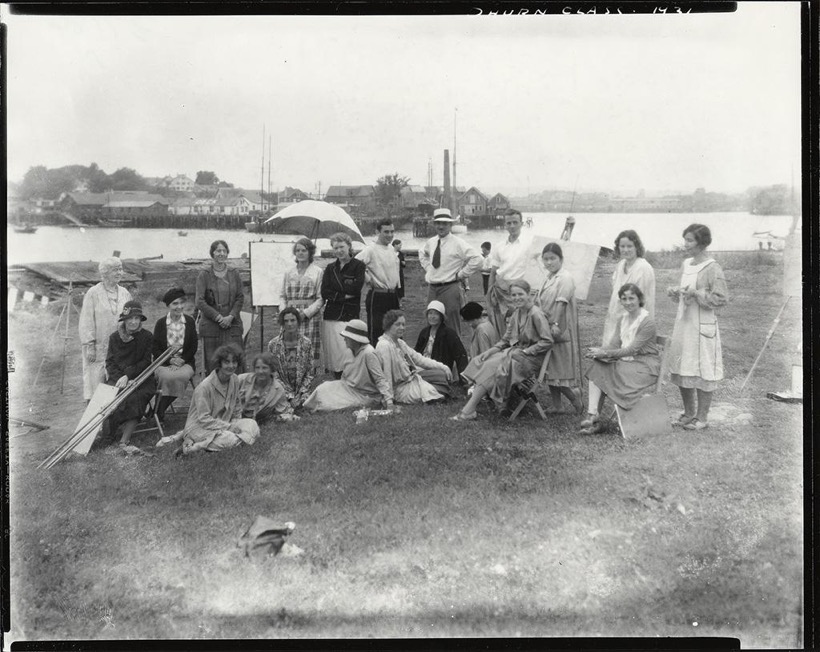
Ernest Thurn. Who? Exactly. He was even forgotten by his students. He's not a household name. One of the countless artists who time and the history books have forgotten. So I had to dig deep to find any information about him. And to debunk some of the information online about him. Let me share what I know so far. Mr. Thurn was born in 1889 in Chicago. He attended University in Chicago and joined an arts club called the Palette and Chisel Club in 1908. 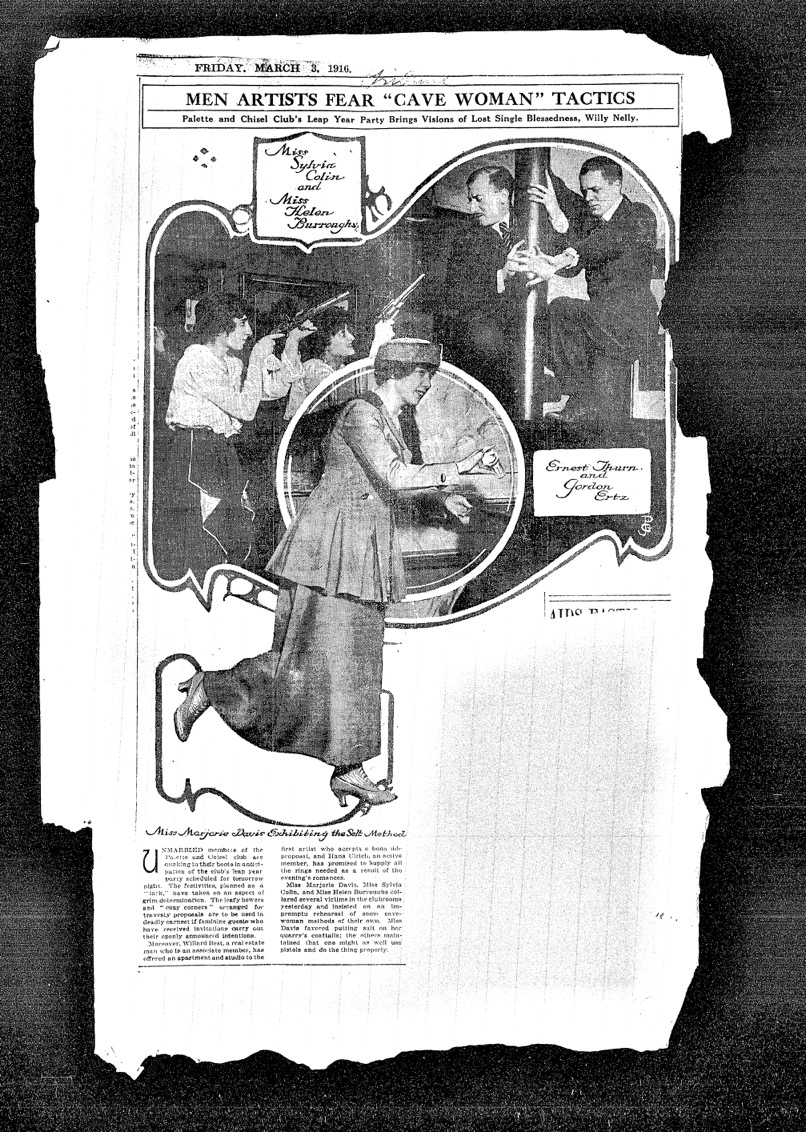
He began appearing in their theatrical events as early as 1911 and would continue to do so through 1921. It appears that he thought of himself as a commercial and illustrative artist, rather than only a fine artist, and exhibited with the Palette and Chisel club in 1914, 1915 and 1916. 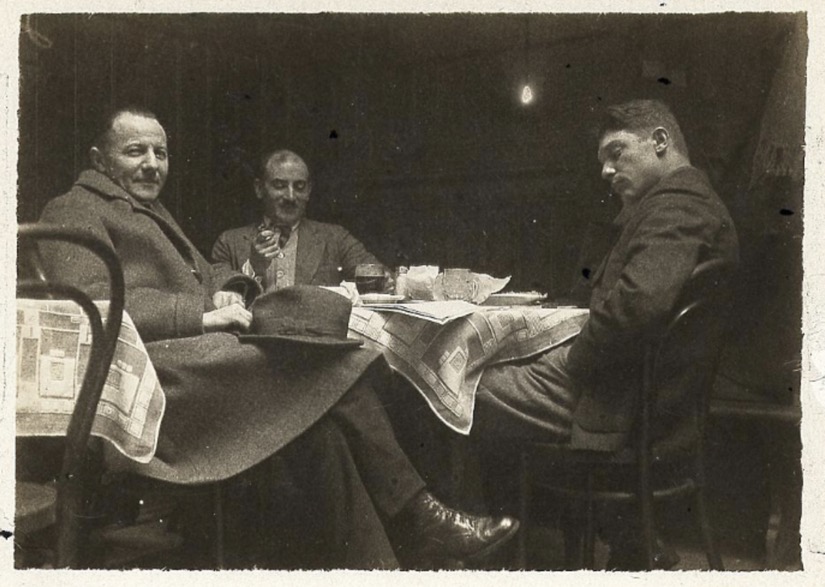
In 1922, Mr. Thurn traveled to Germany and wound up studying under Hans Hofmann until 1927. There's a source online that states Mr. Thurn studied in Paris, France under Andre Lhote at the Academie Julian - this is not true. As far as I can tell, Thurn stayed in Germany from 1922 through 1927. Thurn returned to the States and opened his first art school in the Lincoln Square neighborhood in New York City (often misstated as Lincoln Center) and finally settled his school in Gloucester, Massachusetts. Thurn now considered himself a Modernist thanks to his studies with Hofmann, who he also persuaded to teach at his Gloucester school in the early 1930's. It was here where Thurn met his future wife, Helen Stein, who was a good friend of Marsden Hartley. But Hartley and Thurn did not see eye to eye. One afternoon the pair were driving around Gloucester when Thurn turned and asked Hartley, "What shall we do now?" Hartley replied, "Little I care what you are going to do, I'm going to see Helen." And that was the best of their relationship. From photographic evidence, it appears that Thurn and Stein divorced some time in 1942, just six years after marrying.
I've searched up the scant few examples of his work online and I have to say that none of them look anything like the French Impressionist painting of pollard trees that bears his signature and the date of 1909.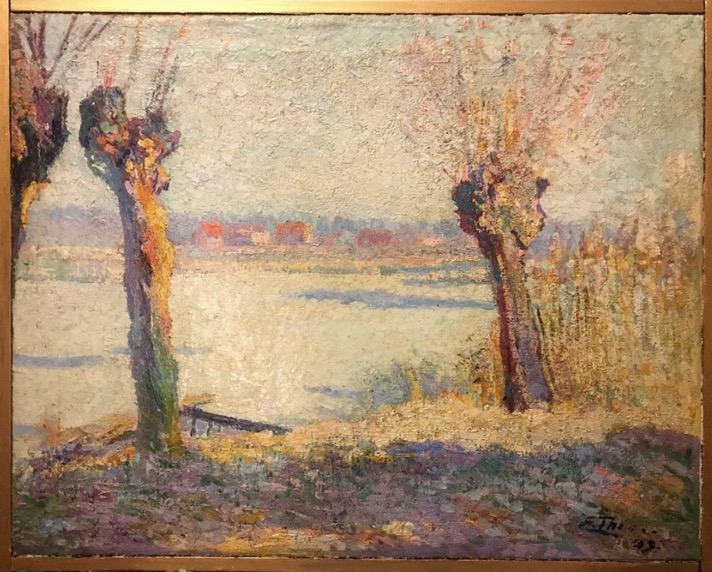
But don't just take my word for it, have a look at these works all by Ernest Thurn and choose for yourself.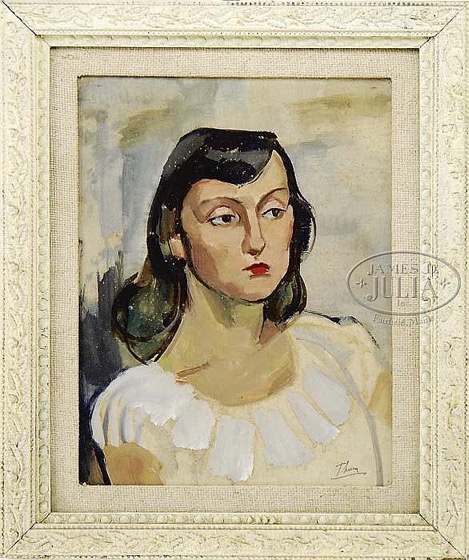
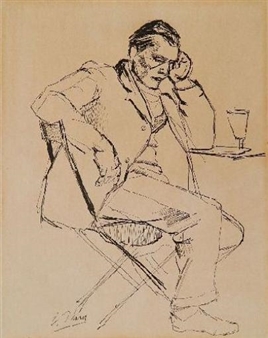
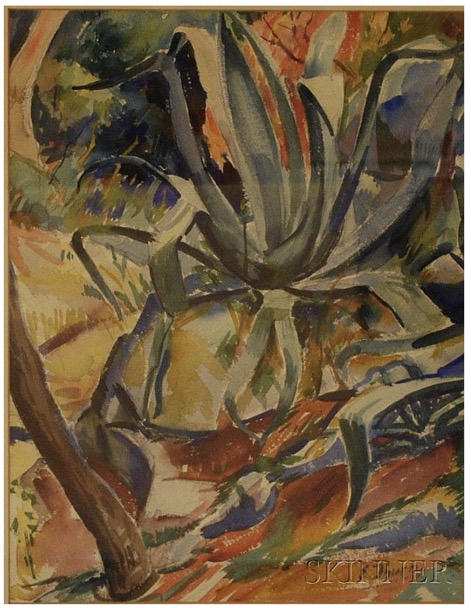
The next few decades until Thurn's death in 1971 provide no information on his life. I could find no information regarding a trip to France, Impressionism, landscape painting or anything relating to the style and genre of the painting that bears his name and the date of 1909. It would appear that I have still more questions than answers but I am confident that Ernest Thurn did not paint this landscape. Now I just have to figure out who did. ;-) hkv
Dumpster Diving
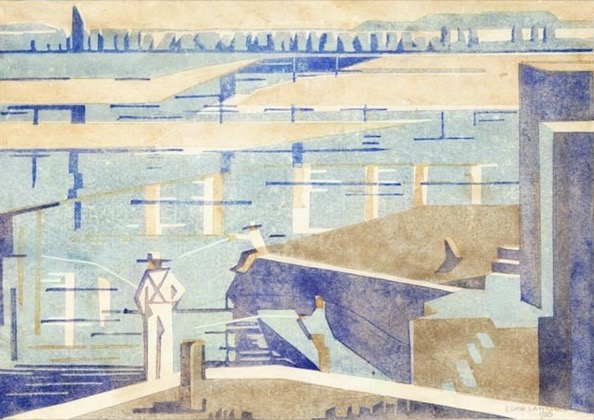
So I walked down the block to the dumpster and climbed up the side. It looked as if a flop house had been picked up off its foundation and shook over the top of the dumpster so that everything would fall out. Mattresses mostly. FYI, I was in a sketchy neighborhood so you figure out why so many mattresses. But I digress. There on top of the pile was this print. So delicate. On paper that was so fine, so unbelievably delicate that it is a wonder how it was not destroyed. Was it simply thrown on top? Had it been underneath a mattress and when they picked it up to toss it in, they flipped it over? I didn’t know and I didn’t want to spend anymore time perched on the side of the dumpster for fear that whatever was on those mattresses would regroup and find it’s way onto me. And so I grabbed the print and headed back to my car. With it safely on the passenger seat I went about shopping. Yes. In a store. Pickins were slim so I headed back to my car to research the signature. I’ll say this, I’m thankful for a good dumpster and I’ve never been shy to dive right in. ;-) hkv
Famous Places, Unknown Artists

Knowing these two things is the start to movement. But in order to know where you are and where you want to be, you have to see the movement. None of that is possible when we are fixated. Case in point, this painting. Perhaps you saw my post on how I took this painting into the bathroom the other day to black light it in hopes of deciphering the signature. I had bought it a couple years ago and was fixated on the name. 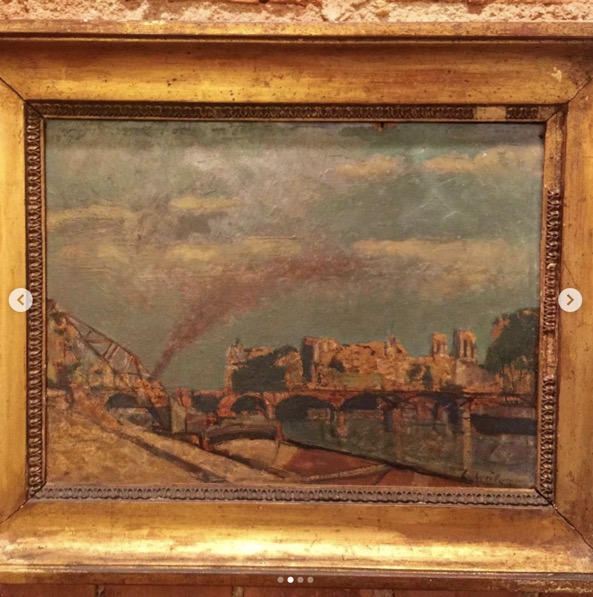
Unable to read it, I gave up. The ‘it’ was my failure at reading the name which I saw as the only entry point to unlocking the story of the painting. So when I black lit it, I had not moved from my previous position - still completely locked in place. That is, until yesterday. I was watching my daughters’ Muay Thai class and listening to the coaches speak about movement. They wanted all the students to move while practicing the combination. 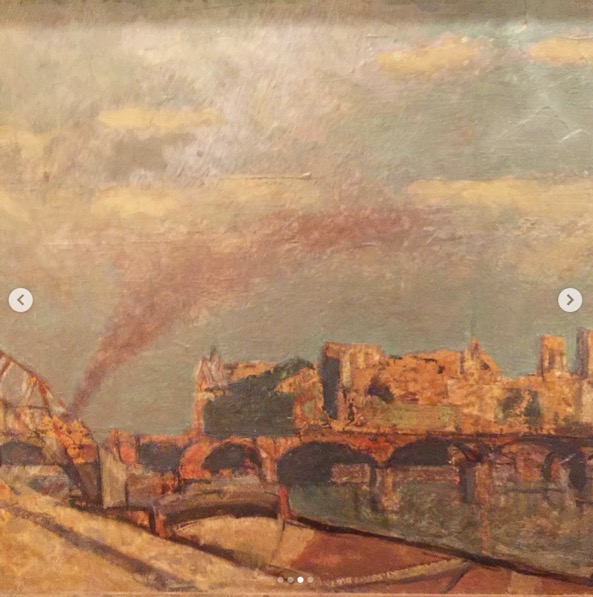
I happened to have my laptop with me, so I did a little moving too. Instead of pinpointing my view of the painting from only one angle, I moved. I keyed in a few terms and started to scroll through images. One after another, each with a different view from a different place. Until I saw where I wanted to be. Along the docks of the Louvre, looking past the Pont des Arts and on to Notre Dame. I was in Paris in the turn of the last Century. Hearing the noises of the cranes on the barges on the Seine. Watching as the river flowed. No, I still don’t know the artist. But I’m moving on the path to understanding the painting. And the Pont des Arts? That’s the bridge that had all the padlocks on it. Locks declaring love. Love locked in place. Well they’ve all been removed. Seems the City of Love prefers not to have its love locked in place. ;-) hkv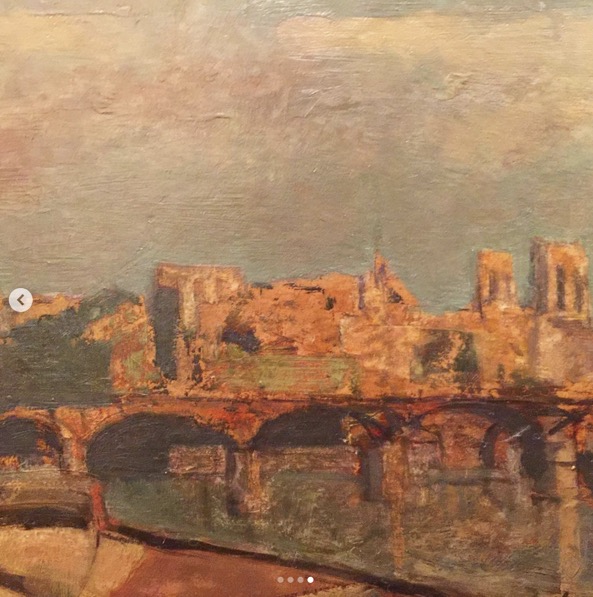
It's What's Under the Surface That Tells the Story

All of this happened over a hundred years ago, but it was what happened recently that I want to tell you about. A fellow dealer had told me about a guy he had heard of who had a portable x-ray machine. I thought this sounded totally legitimate and asked the dealer for this guys number. About a week later this guy showed up at my apartment with his portable x-ray machine - which, by his need for help to carry it up the stairs, didn’t look too portable. 
He was wearing scrubs and told me he had to get the machine back to his office. Still thinking this was at least partially legitimate, I placed the painting on my kitchen table. Before I could ask him if I needed a lead apron like the kind the dentist puts on you before they leave the room to take x-rays of your teeth, he had started up the machine. Click, click. 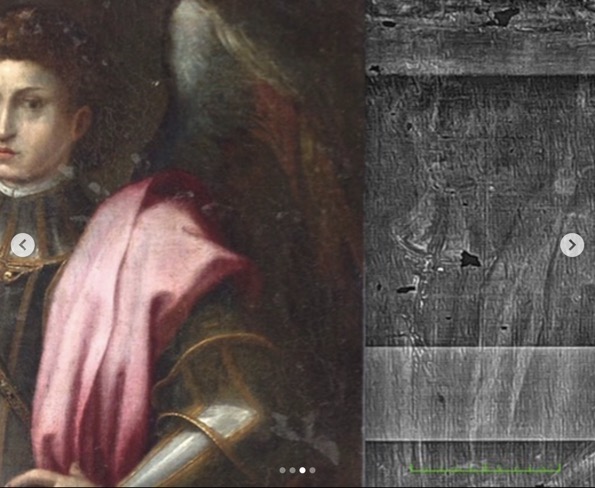
He then handed me a CD and mumbled something about having to download a program in order to see the digital x-ray images as he motioned for me to grab what was now considered my half of the x-ray machine and help him carry it down the stairs and out to his car. When we got to his car, I handed over the cash and he drove off. Still thinking there may be a modicum of legitimacy, I slid the CD into my laptop and hoped for the best. The files were there and the application worked. The digital x-ray images revealed more questions than answers. At least for now. ;-) hkv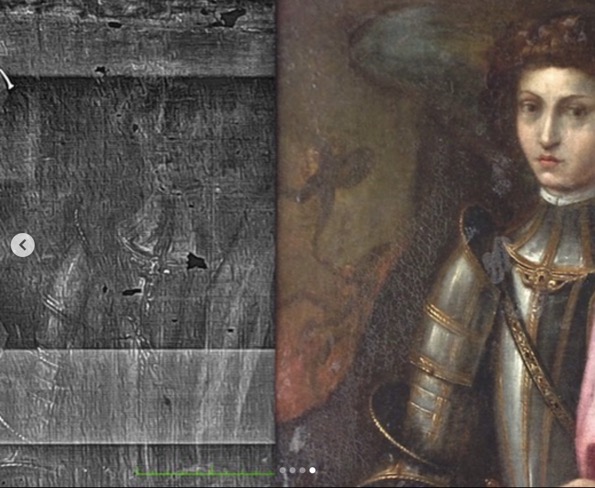
Hidden Messages
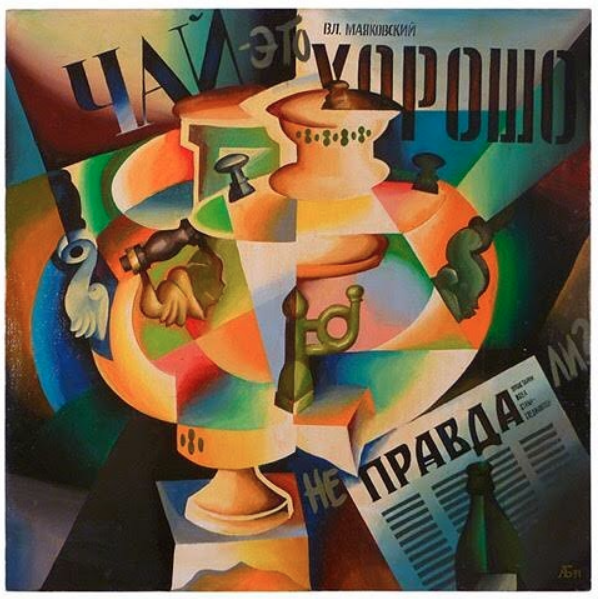
Why, you ask. Because I always bought something great from him and for my daughters it was because he always had Oreos. I call that a win-win. This painting was still unsold after the morning rush of dealers. You see at this time my family and I were living in Connecticut and I would often bring my girls with me to the market. Just not at 3am. More like 9am. Each snug in their half of the double stroller, we wound our way through the Garage looking for treasure. And Oreos. As soon as I saw this painting I knew I needed it. By now you know I love a mystery and this one posed a great sleuthing opportunity. Getting home I quickly went to my computer to begin the task of translating the work. It referred to a famous Russian Soviet poet, Vladimir Mayakovsky. Mr. Mayakovsky was a stand out figure in the Russian Futurist movement as well as supporter and critic of the Soviet State in the early 20th C. Quite a dangerous tightrope to walk if you ask me. The word on the top left is Chai followed by the word for This. Then at the top you’ll see Vladimir Mayakovsky and under it the word for All Right or Nice! Scrolling down you’ll see the word Pravda, which as you know is both the word for truth and the name of the official newspaper of the Communist Party of the Soviet Union. What you may not know is that by adding those letters before and after, the artist changed the meaning of Pravda from truth to untruth. While Mayakovsky died by his own hand some 61 years before this painting was created, this artist aptly told his story through a painting of a deconstructed samovar. With each piece that I buy I am presented with an opportunity to learn, but sometimes it’s the memories of the experience that stay with me. Because every time I think of this painting, I think of my two little girls eating Oreos. ;-) hkv
Extra Information:
I always seem to be getting myself into situations that need an incredible amount of translation. Whether it's hopping on a plane to shop for antiques in Brazil (no, I didn't speak much Portuguese) or buying unsigned paintings (something I've gotten quite good at, if one can be 'good' at such things) or buying paintings from other parts of the world where English really isn't the norm. And that's where I was a few years ago. Translating a Russian painting. Wait a minute, did I say translating a painting? Yes. This particular work by contemporary Russian artist Anatoly Belkin is full of symbolism and words. In Cyrillic.
Looking at the painting one late morning at the New York City flea market (I couldn't go at my usual early hour), I knew that it was something special. I spoke with my friend about the painting and as antique dealers are apt to do, he tried to talk me out of buying it. "Heather, everyone has seen this already", he said. I bought it anyway. The business is a funny one and if a dealer thinks that all the 'right' people have already seen something and passed on it they sometimes lose a little faith in it. It only makes sense because we as dealers are buying on our own taste. If those choices are not validated by a sale, we begin to think that we made a mistake. It's just how the business works. But, back to the painting...
I asked my friend what it was all about and who the artist was. His only information was that it was a painting of a samovar and was full of Russian words. There are plenty of dealers at the flea market who speak Russian, but I chose to try my hand at translation. First though, I had to figure out who actually painted the painting. Signed with a monogram and dated 91, I couldn't wait to get home and begin my search. Trying a few different online sites, I finally found the one that gave me my answer (for just $25 per year). The monogram Ab is for Anatoly Belkin. Turns out he's alive and well and painting in Russia. He was born in 1953, went to art school in Russia and works in St. Petersburg. Great. Now, what does the painting say? Looks like another search is in order...
Found another great site, this one to translate the Cyrillic alphabet. Working the letters out and then searching again gave me my answers. Sort of. The painting says a lot about tea. And Soviet poets. And truth. Or actually un-truth. So, here goes. At the very top is the name of a famous Soviet poet Vladimir Mayakovsky. Mr. Mayakovsky was born in 1893 and lived a life that he cut short, committing suicide in 1930. Those years in between were filled with protests, jail terms, love affairs, poems, stage plays, friendships and so much more. He was close friends with David Burliuk and the two would explore Futurism in it's many veins. They were known to stand on street corners reciting poetry and throwing tea at their audiences. This was to annoy the bourgeois art establishment. From what I read, they were quite successful. In another refernce to tea, Mr. Mayakovsky is know to have said about Anton Chekhov, "Language is as precise as 'hello' and as simple as 'give me a glass of tea". There is also a famous poem by Mayakovsky where he commands the sun to stay with him and have a tea.
And what is all this talk about tea? Well, the samovar is the main focus of the painting. At the top left, there is the simple statement, "This is tea". And below that one reads the word for 'very good". It was all starting to come together. Sort of. And now for the truth, or rather un-truth. The newspaper Pravda features quite prominently along with the slogan, Workers of the World Unite! But what are the letters before and after Pravda? Well, the addition of those letters turn Pravda (truth) into un-truth or falsity.
So what does this all mean? Not sure yet. Literal translations of art are pretty superficial. The truer deeper meaning is in the understanding. And for that understanding, I spent some more time with the painting and my computer. Searching for the answers and the understanding.
From the Flea Market to Central Park South
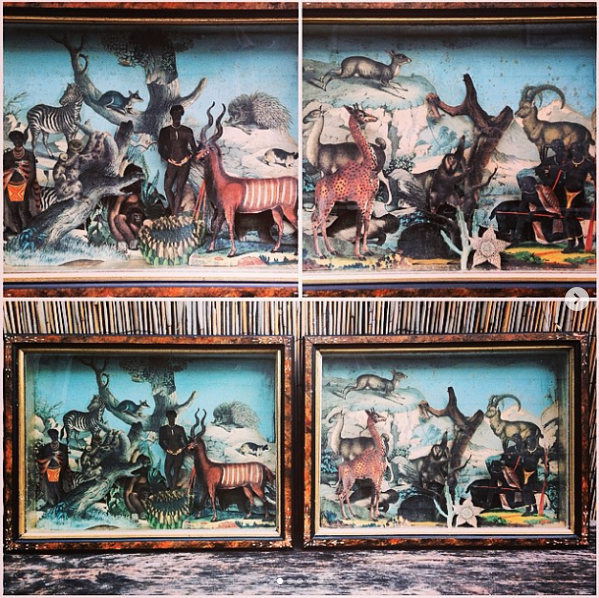
Dew coated the tables set up neatly in rows at the Golden Nugget flea market. Making my way along them with the light from my cell phone I came across a dealer just beginning to unpack. This is that special moment when the merchandise is just about to hit the table and if it was good, then it would surely be snapped up before the dew could touch it. I saw one of the dioramas in the hand of the dealer. “Could I see that please?”, I yelled out before anyone else. She informed me that it was actually one of a pair. Even better I thought, though I had no idea what I was looking at. 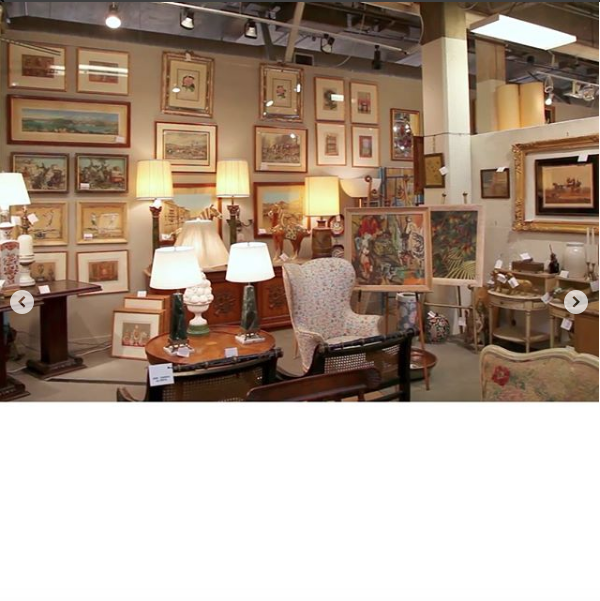
With both now firmly in my grasp I examined the frames first, but you could’ve guessed that. A couple of Victorian era paint decorated frames which helped to date them to the late 1800’s or early 1900’s. It’s always good to have a starting point. Now came the fun part. What where they? And maybe more importantly, why were they? The what was a pair of hand colored paper cut out dioramas depicting various animals from the continent of Africa. The why was still elusive. 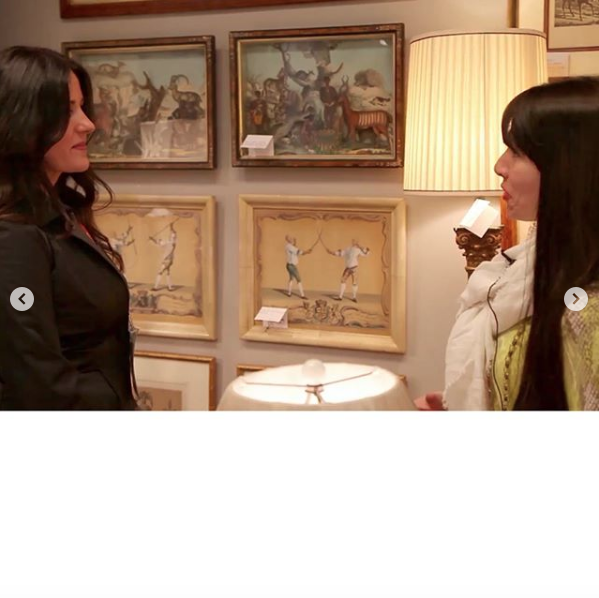
Maybe they were created to remember a holiday spent abroad? Maybe they were the fantastical creations of a zoologist? Maybe they were simply incredible and had to be bought? I went with option 3. It wasn’t till well after sunrise, and a few more coffees, that I actually had a good look at them. They were wonderful. Back home, I packed them securely for the High Point Market show. I placed them on the back wall of my booth among several other pieces. 

They were spotted immediately by a well known New York City interior designer and they are now in her residence on Central Park South. Dr. Seuss said it best, “Oh, the places you’ll go” ;-) hkv
Sink, Swim or Tread

So a few years ago I was in Philly and heard about an auction of antique picture frames at a local art gallery. Curious, I went to see if I could buy a couple lots. Turns out, that I bought more than a couple. I bought about 250. Freestyle. Back stroke. Doggy paddle. It was time to swim! Or in my case, tread water. And then I had to figure out just what to do with all those frames. Logistics were the easy part - rent a truck and load it. Then what? More treading water, that’s what. I got all the frames unloaded and into storage so all that was left was to sell them. 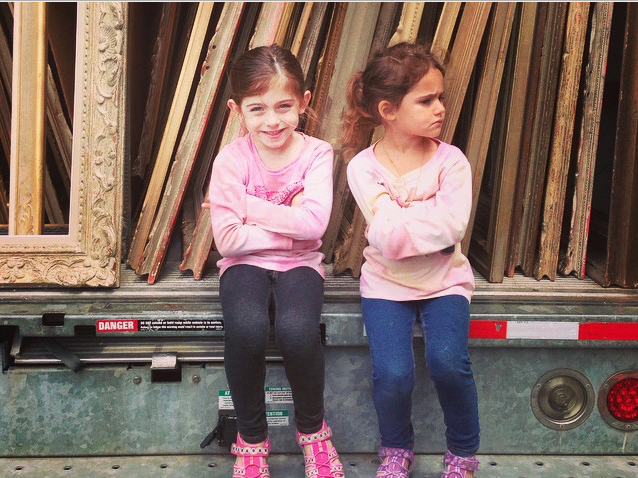
At this point I’m thinking back to an episode of Magnum P.I., you know the one where Magnum falls off his kayak and swims the opposite direction from it and has to tread water for eleven hours or so before Rick and T.C. rescue him? Yeah. I was feeling like Magnum at this point. Strong. Invincible. Water logged. Just without the mustache. I scrolled through my contacts to one dealer. A great friend who I knew could buy the whole lot. And just like that, I was once again loading the frames. But this time into his truck. So what’s the moral of the story? Jump in, baby, the water’s fine! :-) hkv
The Barter System
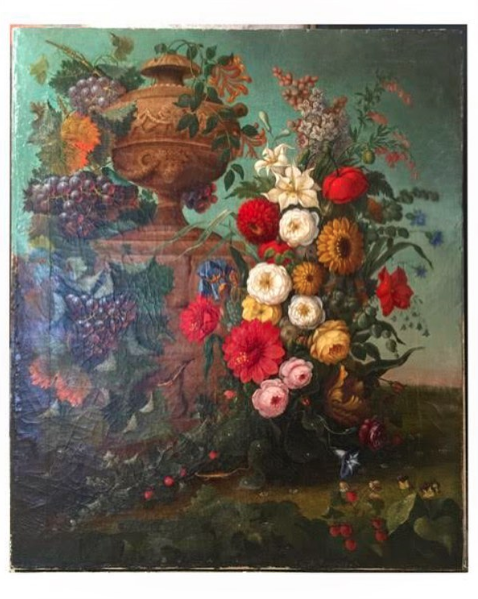
You see, I had sold something to another dealer and he paid me with this painting. When I got it, it was barely hanging on to it's replaced stretcher. It had a super dry surface. It was in serious need of restoration. It was unsigned. It had no original frame to aid in its attribution. It was a mess and a mystery. And I loved it! I jumped at the chance to go back to the barter system. I thought of famous artists who paid their tabs with paintings, drawings, scribbles on napkins. As I saw it I was way ahead of the game. Then came the restoration. With a light touch, my restorer edge lined the painting and built a new stretcher. Now with a fresh coat of varnish, the painting was ready to hang. No longer a mess, but still a mystery. Have you Googled "Dutch+still+life+painting" lately? I have. And let me tell you, they all look alike. I know I'm not supposed to say this, but my eye is not honed to see those subtle differences. Yet. Is this 19th Century? 18th Century? Did I totally luck out and buy, um trade, a 17th Century Dutch still life painting? The short answer is I don't know. But the clues are there. The outdoor setting. The combination of grapes and flowers. The little lizards walking around. The urn itself. Even the types of flowers. It's all there. And for now it's all gonna stay there. Or more to the point, in my hallway. As another work in my favorite unsigned mystery collection category, I'll continue to Google the keywords until I get them just right. It will be then when the artist, their style, their technique becomes so blindingly obvious that I'll wonder how I didn't see it years earlier. ;-) hkv
Holding Out for a Hero
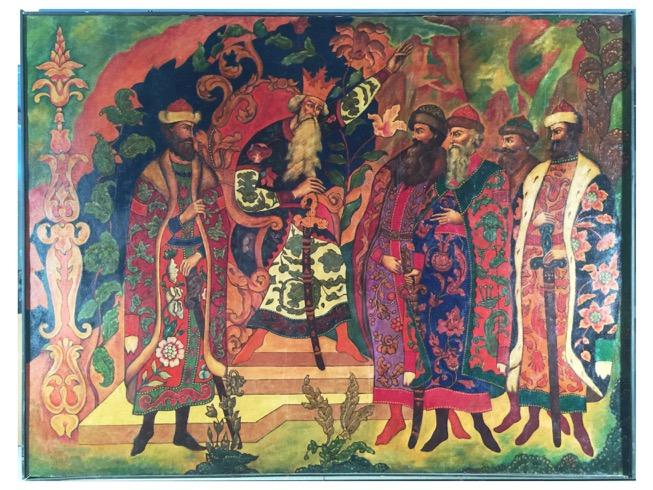
Upon entering the battle his weakened forces suffered many losses at the hands of the Mongols and Prince Igor was captured. After some time his captors organized his escape and Prince Igor returned home. Defeated. But with a second chance... The chance to return home. This painting is one of three which tell the Russian epic poem from the 12th Century of an unlikely hero and his faults, his missteps and his return. 
These oil paintings have also made a return. A return to the family of the artist - they have come full circle. Through diligence and research and sheer good luck, today I made a delivery and brought the art home. I had bought these paintings years ago. They had made their journey and I had come across them. Rolled up. 
Told that all the other dealers had passed on them so they must be of little value. Value. What is valuable? History. Legacy. Stories passed down from one generation to the next through art. I think of myself as a vehicle taking art from the past and bringing it to the future. Generations to come will know the art of their ancestors. I am honored to be part of the history of these paintings and their legacy. ;-) hkv
Extra Information:
Eugene Andrew Agafonoff (Evgeny Andreevich Agafonov) was a Ukrainian painter, graphic artist and scene-designer who was born in 1879. He was born to a family of merchants. He got his first art education in St. Petersburg Academy of Arts in 1899–1907. He studied under the guidance of P. Kovalevsky and F. A. Roubaud. In 1910 Agafonov was awarded gold medal for the painting Draymen at the regional South Russia exhibition in Ekaterinoslav. In 1905–1907 during the Revolution, Agafonov illustrated Kharkov satirical magazines Shtyk (“Bayonet”), Mech (“Sword”), Zloy Dukh (“Malignant Demon”) and others. In March 1906 Agafonov together with A. N. Grot, V. D. and D. D. Burlyuk participated in the 7th exhibition of the Cirlce of Kharkov artists (1900–1908). Since 1908 he exhibited his works at the exhibitions of the Association of Kharkov artists, at the exhibition of the group Zveno (“Link”) in Kiev (1908), in Rostov-on-Don and Kursk. In 1909 Agafonov founded the experimental theatre, Blue Eye, in Kharkov on the basis of the avant-garde studio Blue Lily. He designed a lot of performances for this theatre, including The Stranger by A. Blok. The theatre worked only two seasons and was closed in February 1911. Later Agafonov left the Association of Kharkov artists and organized an avant-garde group Koltso (“The Ring”, 1911–1914). Members of the group were A. N. Grot, A. M. Zagonov, N. R. Savvin, M. S. Fedorov, E. A. Shteinberg and others. In 1913 Agafonov joined the group Bubnovy Valet (“Jack of Diamonds”), took part in the exhibitions of the group in St. Petersburg. Agafonov participated in the First World War; in 1918 he returned to Kharkov. In the same year he designed covers of the Theatre Magazine . Agafonov joined the group Khudozhestvenny Tsekh (“The Art Guild”); in 1918–1919 he together with M. A. Voloshin, Mane-Katz, and E. A. Shteinberg took part in the exhibitions of the group. In 1919 Agafonov lectured as an art critic in the studio of painting and drawing under the ProletCult (Proletarian Culture). He also exhibited his works at the First exhibition of the Art department of Kharkov Soviet of worker’s deputies. Evgeny Agafonov painted a lot of portraits including Lieutenant P. P. Schmidt’s lawyer, A. Alekseev (1906) and portrait of the actress V. F. Komissarzhevskaya (1908). In his paintings Agafonov often used Ukraine national motifs. He also painted landscapes, drew sketches and did drawings. In early 1920s Agafonov immigrated to the USA. He was engaged in easel painting, graphic art and advertising. He exhibited his works at the exhibitions of the Society of Independent Artists (1929); in the French gallery in New York (1931); in the Greenwich public library (1939); and in Derby, Connecticut (1943). Personal exhibitions of the artist were held in the Cas-Delbaut gallery in New York (1931). Works by Evgeny Agafonov, which the artist left in Kharkov, were kept in Kharkov Art Museum. During the Great Patriotic War, the greater part of his works was lost. Only several drawings and theatre designs remained in Kharkov Art Museum." Mr. Agafonov died in 1955. *Info from Art Investment Russia
Is It Jean or Hans

That's the life I've carved out as an antique dealer and art dealer. Am I big time? Hardly. I'm a hustler and a picker. It's the deal that I love. The energy in the hunt. You could say the thrill of the hunt. But for me it's even more. It's the chance to hit it big. To win the lottery if you will. And it's not just the money (don't get me wrong, the money will be great) but it's also the feeling that something important in the eyes of the art world is now in my possession. And here we come to this carved stone abstract sculpture that I bought under the El in Philly five years ago or so. To me it's Jean Arp / Hans Arp all day. Think dada, surrealism, abstraction, bio-morphic sculpture guided by nature. Human Concretion Maybe. Just maybe. Or it's a cool sculpture that I bought one blisteringly hot summer day in Philadelphia when the mercury had hit 95 and the humidity had hit 100. But hey, that's summer Philly style. So maybe the heat got to me. Or maybe I have a masterpiece in my living room. Time will tell. For now it remains $80 bucks well spent. I guess I'd better send out that email to the Fondation Arp. ;-) hkv
A Sergeant or a Sargent

I bought this oil painting back in 2009 from a friend and fellow antique dealer. There's an old joke that goes like this, "There are two antiques dealers on a deserted island. Business is great." Ha! That couldn't be more true. We are a bunch of merchants, historians and peddlers who thrive on the hunt and the deal. We search out the rare. The sublime. The unique. And we get each other. It's the story behind the piece. It's the research on the piece. It's being part of the history of something as it passes from one hand to the next. From one generation to the next. We are simply the vehicle to carry it forward. This antique painting from the 19th Century has always had a great appeal to me. I love a mystery. Who is she? Why is she playing the violin for someone. Who is this man? Is he a soldier who is dying? What is their story? Their connection? And why, oh why, didn't the artist sign the painting!?!?! I will soon see what develops from the x-ray photography and I'm hoping that it will reveal some of the secrets and the answers. In the meantime, if you ask me, it has a John Singer Sargent vibe to it. ;-) hkv
Extra Information:
Have I mentioned that I am quite good at buying unsigned paintings? Yes? Oh, wonderful then you know already. For those of you who are new to my blog, here's a little backstory: I am always buying things that I know very little about. There. I said it. It's part challenge and part gamble. It's what makes the antiques business fun. Reaching out and trying your hand at something new. This painting is no different. Actually, it is different. Very different...
So, I had just given birth to our second child a week earlier. A dealer friend of mine had called to see how we were all doing (awesome, thank you) and also wanted to show me a few things. Maybe the paintings were first on his mind, but I like to think it was the other way around. So, he makes the drive over to our apartment and I met him in the lobby. The first two paintings were not for me (though I bought them against my better judgement and lost money, but that is a WHOLE other story - P.S. always go with your gut rather than a signature...) and then he showed me the third painting. Wow. Strong. Emotional. It wasn't my hormones, it was the painting. It had been re-lined at some time, maybe 70 years ago or so and was an oil on canvas dating to the late 1800's, I thought. Looked like an American canvas and stretcher. And now to the interesting part. The painting. A woman in a white dress playing the violin sits on the edge of a bed. A man (who looks like some military type) is lying in the bed propped up on pillows dressed in a white shirt with red around the cuff. The room is bare. A brown dresser and blue chair are the only furniture. There is a crucifix above the bed. Trust me, it is an emotional piece. Asking my friend about the piece yielded nothing. An, "Oh, I'm not sure. Could be something good. Maybe an illustrator. Definitely American, Sargent? I had a couple other names in mind..." You know the story. So, we reached a price and I brought the paintings back up to our apartment. The whole deal lasted about ten minutes. Just long enough for the new baby to fall asleep. And yes, the door closing did wake her up...
So after some time with the family, I began on my search for an artist. I tried illustrators. I tried American painters. I tried violin players. I got no answers. Days turned into weeks and those turned into months. Zilch. We were planning a trip to Brazil, so I packed up the paintings and put them into storage. And there it sat. About six months later, I was reunited with the paintings and I was happy to be hanging them in our new apartment. When the time came to unpack this one, I was seeing it with fresh eyes. Sitting down at the computer I typed in four words: woman violin soldier painting. Bingo. Sort of. Turns out there's a Civil War ghost story about a woman who plays the violin for a dying soldier. It's a North South romance. Very touching. I felt that I had made a huge breakthrough. Could this painting symbolize the story? Tell me what you think...
The story goes, during the Civil War the Martha Washington College for ladies was turned into a hospital of sorts to care for wounded soldiers. The college was located very much in the South, but took on patients from either side. A few of the students enrolled in the college stayed on as nurses and nurses aides. One day a seriously wounded officer from the North was brought in. He was brought in and cared for by the doctors and nurses. One of the students who was assigned to his care, began to fall in love with him. She was a wonderful violin player, not much of a nurse. When the wounded officer would need some comfort, he would ask her to play violin for him. Legend has it, that he called out to her to play something. She obliged and he peacefully passed away. She would die a short time later, some say of a broken heart.
The Martha Washington College is now the Martha Washington Inn. Some say that to this day, the sounds of a violin can still be heard coming from the room where the Northern soldier and Southern student had fallen in love. And the painting remains a bit of a mystery, but one that is at least a bit closer to an understanding. Now, if I could just figure out the artist...
An American Hero Comes Home
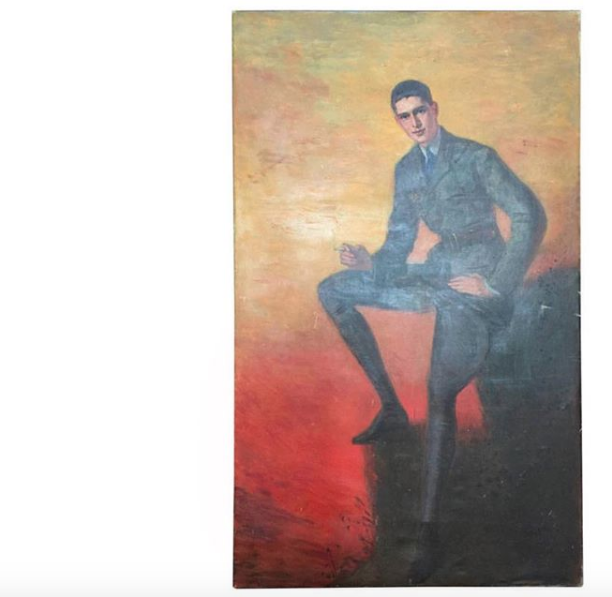
This painting tells the story of Henry Howard Houston Woodward. Born in Chestnut Hill in Philly and educated at Yale. Henry was a charismatic young man who gave his life so that others could be free. Serving first in the Ambulance Corps, Henry's superior officers saw his determination and grit. He was allowed to join the aviators and was soon flying missions. It was on one of those missions that Henry lost his life. His story will always be told though the power of art. I discovered Henry's identity through many late nights in front of my laptop. Even though the painting was signed by the artist Marie Eristoff Kazak, the sitter's identity was not mentioned. His World War I French aviators uniform was my first clue. This eventually led me to a book of his letters published by Yale University press called A Year for France. It was in this book that I found an image of the painting. Henry had written home to his parents and asked if they would wire him the money to have it painted - he wanted there to be a record of him should anything happen. His beautiful letters and this painting tell his remarkable story. This work is now in a Philadelphia area museum. ;-) hkv
Extra Information:
When it is a person. Wait. What? Okay, here’s what I mean. Back in the Summer of 2014 I attended an auction at the warehouse of a once prominent gallery. I was there for the picture frames and I bought about 250 of them. One of the last lots of the auction was a heavy cardboard tube that supposedly contained a rolled up painting. So, being the impulsive gambler and dreamer that I am, I simply kept my hand in the air till the lot was mine. Now I had to hope that there actually was a painting in it. I’ll skip over the excitement of loading a rental truck with 250 frames and then unloading all of them and get right to the good stuff... So, back at my showroom, I carefully removed the canvas from the tube and began to unroll it on my eight foot work table. And I unrolled it. And unrolled it. It was massive. A face was staring at me. A young man in uniform holding a cigarette in his hand staring right at me. Quickly I looked for a signature and found it only after the light caught it just the right way. I first saw a monogram of a crown and then the hyphenated last name Eristoff-Kazak. Fantastic. A signature often makes the research that much easier. Boy, was I in for a surprise. Turns out Eristoff-Kazak was actually Russian Princess Marie Eristoff-Kazak (born Etlinger Mariya Vasilevna later using the names Mary Kazak, Maria Eristova and Marie Eristoff Kazak) a painter of the Russian aristocracy. She was born in Saint Petersburg in 1857 and studied art with the Hungarian born court painter Mihaly Zichy. In 1887, Marie Etlinger married Georgian Prince Dmitry Eristavi. Mr. Zichy brought the Princess to Paris for the first time in 1890, she would later move there permanently in the early 1890’s and become a fixture on the Paris art scene. Her reputation grew and she became known for her portraiture of the Russian aristocracy visiting or living in Paris. The Princess had a long career in Paris, while also sending her work for exhibition to London and St. Petersburg. She died there in 1934. So, now that I’ve learned a bit about the artist I can begin the process of discovering the identity of the sitter. I’d like to digress for a moment and share a similar story about a portrait, a discovery and a story...
Earlier in the year, Colin Gleadell who is an art world reporter for the past 27 years and a regular contributor to many publications including writing a weekly column for The Daily Telegraph’s Art Sales page, reported on a portrait that sold at an auction in the countryside of London. While this would not normally merit inclusion into one of Mr. Gleadell’s columns, this was no ordinary portrait. The artist, Ambrose McEvoy - a London society painter who died in 1927, never really achieved high results in the auction world. Yet this portrait of an unknown woman (which carried a presale estimate of just $1067.) would bring $62,846. Whoa. They say, it just takes two to make a record. Boy were they right. But why all the interest you ask? And just who bought this work? I’ll tell you. Actually Mr. Gleadell coaxed the answers from the buyer, none other than Mr. Philip Mould a London gallery owner specializing in portraits. It seems that Mr. Mould has become quite well known for uncovering the identities of the sitters of the portraits he purchases. And this one was no different. The sitter was a Ms. Lois Sturt a British silent movie star who was born to a Baron in 1900 and died in 1937. Described by her biographer William Cross as a “wild child” and “the brightest of the bright young things”. There’s more to this story and if you want to read it, click here for the full article in The Telegraph. Just make sure to come back here and read why I thought it would be important to tell you about this story...
Now back to the painting in my inventory. Where were we? Oh, right. The Russian Princess artist. Seems she was quite the bohemian artist for being a Princess. Always giving of her work and her time. Living the life of an artist in Paris during the early 20th Century. But just how did she come to paint this portrait. And just who is he. I’ll tell you. Because Mr. Mould is not the only one who can uncover the identity of a sitter in a portrait. Turns out he is none other than Henry Howard Houston Woodward, part of the very prominent Houston Woodward family of Philadelphia (by way of Wilkes-Barre, originally from Connecticut). In 1917, Henry was enrolled at Yale University and set to graduate as part of the Class of 1919. It was during February of that year when Henry volunteered for World War I. He was shipped out to France just two months later. The ship carried him along with hundreds of other volunteers, cargo, trucks, supplies and more. The cross Atlantic journey was slow and Henry was chomping at the bit to arrive in France. Shortly after arrival, Henry’s section of drivers - the Ambulance 13 corps were placed on the front lines in some of WWI’s bloodiest battles. Henry’s bravery, intelligence and determination were quickly recognized and rewarded by his superiors. Henry wanted more responsibility and more action. He had begun training to become a pilot for the French and was quickly excelling in his classes. His hard work was rewarded with extra time off and he received additional days to spend in Paris. And this is where our story takes a turn.
It was in Paris where Russian Baron Eugene Fersen was escaping the aftermath of the Bolshevik Revolution serving as the head of a Russian Mission. The Baron, born in St. Petersburg in 1873, was the eldest son of a Grand Duchess who was a mistress to (it is reported) Czar Nicholas II (you know, the Bloody Czar...). He was quietly living in Paris and working on his manifesto which would later become the Light Bearers Society and the Science of Being (the Baron and his mother later moved to the United States, bought a gilded age mansion in Seattle owned by an imprisoned con man and used that as the headquarters for their society until his death in 1954). But, I’m getting ahead of myself. Back to Paris. The Baron was close friends with the Princess and offered a few rooms in his apartment for her to use as a painting studio. It was around this time that the Baron met Henry. The exact details of their first encounter are not known, but we do know that the two shared a very close and personal relationship. The Baron was quick to recognize Henry’s first rate character and Henry was enamored by the tales the Baron would tell of his family, his life in Russia and all that the Baron promised him after the war. The two spent as much time together as the war would allow. And it was on one of those weekends together when Henry met the Princess. She, too, recognized something special in Henry and asked if he’d like to have his portrait painted. She saw in him “an Egyptian face, ancient Egypt, that is, not modern”. The Princess painted Henry with “a classic mouth, long, straight nose, high cheek bones, and long sphinx eyes!”. And Henry knew that the Princess was “really a genius” and was “about the best portrait painter in Europe now, and in France for certain”. You could say that the two really hit it off. Henry had asked his family back home in Philadelphia for the 5000 Francs (about $1000 at the time) to pay for the portrait and said that “it would be a good souvenir in case anything did happen to me.”
Sadly Henry’s words would be prophetic. Just two weeks after having his portrait painted1918, Henry’s plane would be shot down over the small town of Montdidier, France. It was not until 1919 that the plane would be discovered. Henry’s family travelled to Montdidier sometime in 1920 to erect a monument to their son, help to rebuild a cathedral in the town that had been damaged in the war and to collect his personal belongings. This painting was among them. Once the belongings arrived back in the States, the painting was to remain rolled up. Forgotten. If not for that auction, Henry’s story would also have been forgotten. Now it will live on forever thanks to the Power of Art. Oh, and some detective work.